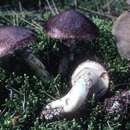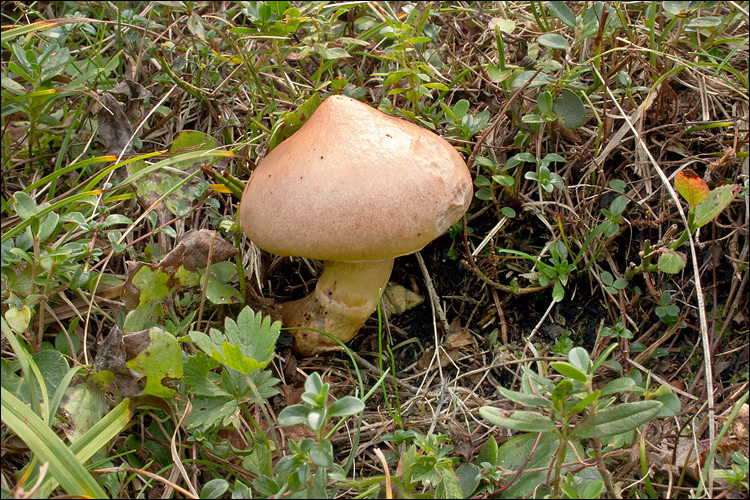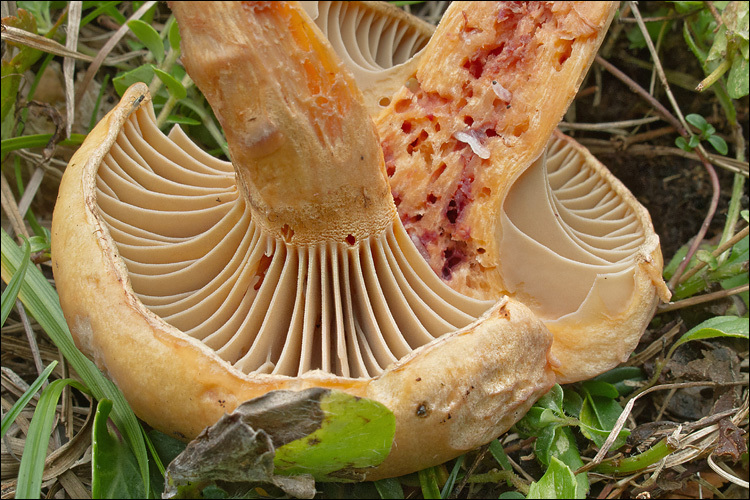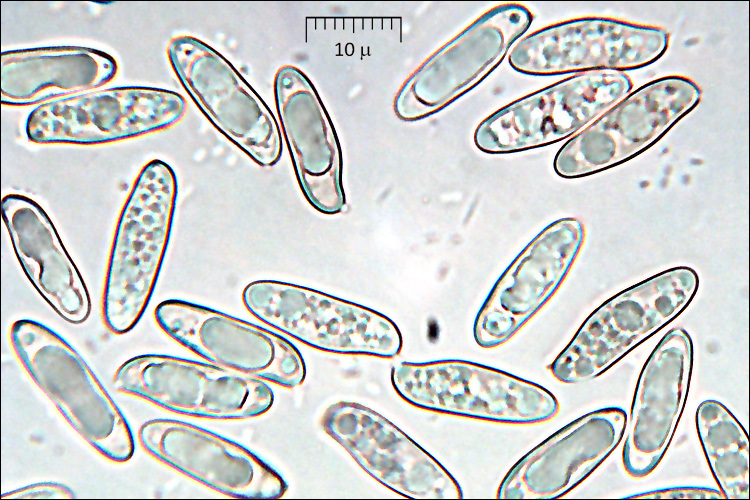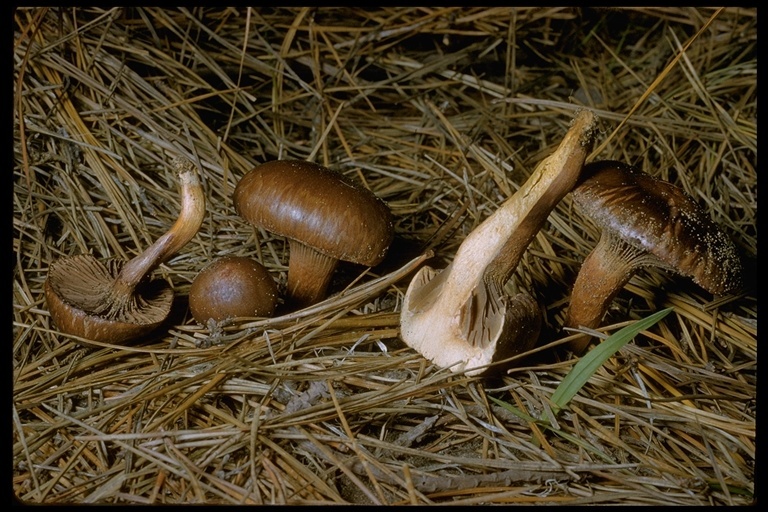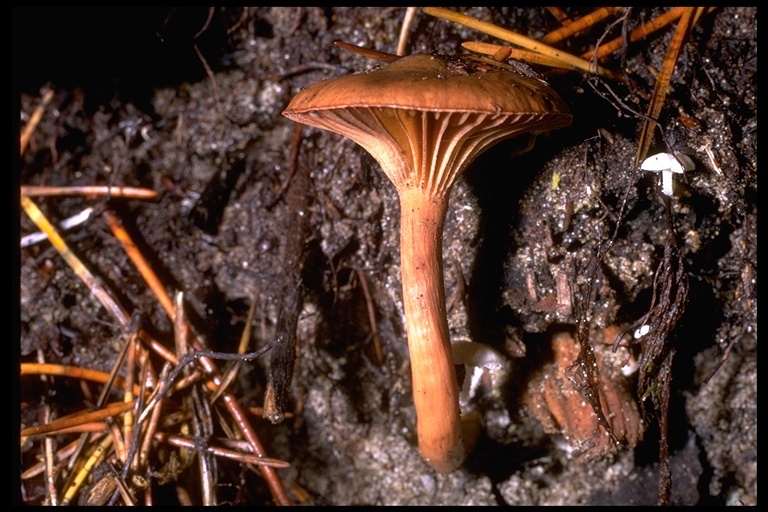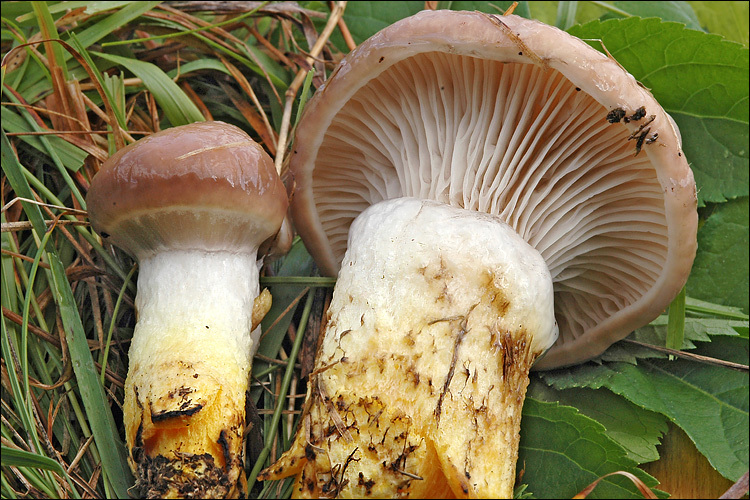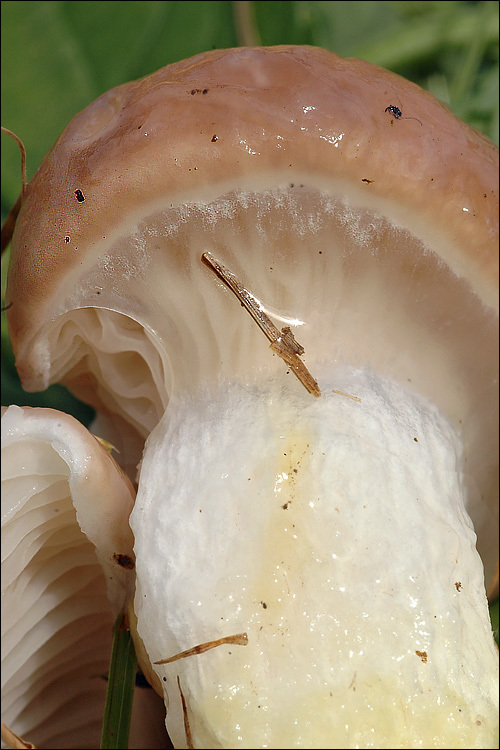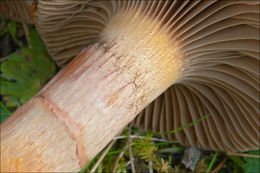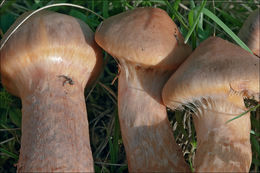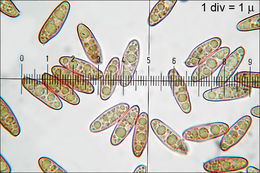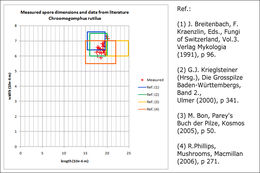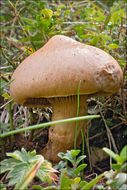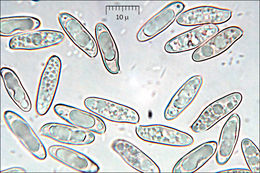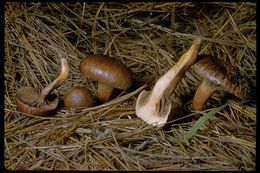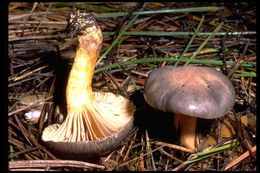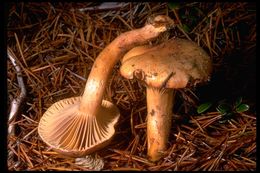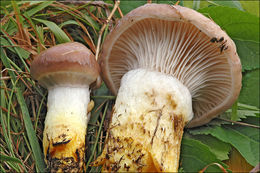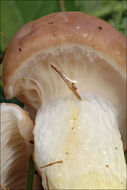-

Slo.: bakreni polar - syn.: Gomphidius viscidus (L.) Fr. - Habitat: sandy grassland; mixed broadleaved and conifer wood edge; Picea abies, Pinus sylvestris, Salix eleagnos in the vicinity; semiruderal, calcareous ground; flat terrain; dry, half sunny place; exposed to direct rain; average precipitations ~ 3.000 mm/year, average temperature 7-9 deg C, elevation 580 m (1.900 feet), alpine phytogeographical region. Substratum: soil. Comments: Croomogomphus rutilus is a quite common fungus in this region. Two other species Chroomogomhus helveticus and C. glutinosus grow in the same region. It is not always simple to tell them apart. C. glutinosus is normally very slimy and grows always under Picea abies while Croomogomphus rutilus grows only under two-needle pines. C. helveticus is rarely slimy but grows under Picea abies, two- and fife-needle Pinus species. Inamyloid hypha of the pileipellis is another more demanding distinguishing character. Spore dimensions are very similar of all three and hence of little help in discrimination. Different mycorrhizal partners also did not help in identification of this find since Picea abies and Pinus sylvestris (a two-needle species) were in the vicinity. Yet, characteristic copper tone of the pilei seems to be quite a reliable feature for Croomogomphus rutilus. Growing in small groups of a few fruit bodies and solitary; SP abundant, grayish-brown. Spores smooth. Dimensions 17,3 [18,5 ; 19,1] 20,3 x 5,8 [6,4 ; 6,6] 7,1 microns; Q = 2,6 [2,8 ; 3] 3,2; N = 24; C = 95%; Me = 18,8 x 6,5 microns; Qe = 2,9. Olympus CH20, NEA 100x/1.25, magnification 1.000 x, oil, in water, fresh material. AmScope MA500 digital camera. Ref.: (1) J. Breitenbach, F. Kraenzlin, Eds., Fungi of Switzerland, Vol.3. Verlag Mykologia (1991), p 96. (2) G.J. Krieglsteiner (Hrsg.), Die Grosspilze Baden-Wrttembergs, Band 2., Ulmer (2000), p 341. (3) M. Bon, Parey's Buch der Pilze, Kosmos (2005), p 50. (4) R.Phillips, Mushrooms, Macmillan (2006), p 271. (5) S.Buczacki, Collins Fungi Guide, Collins (2012), p 422.
-
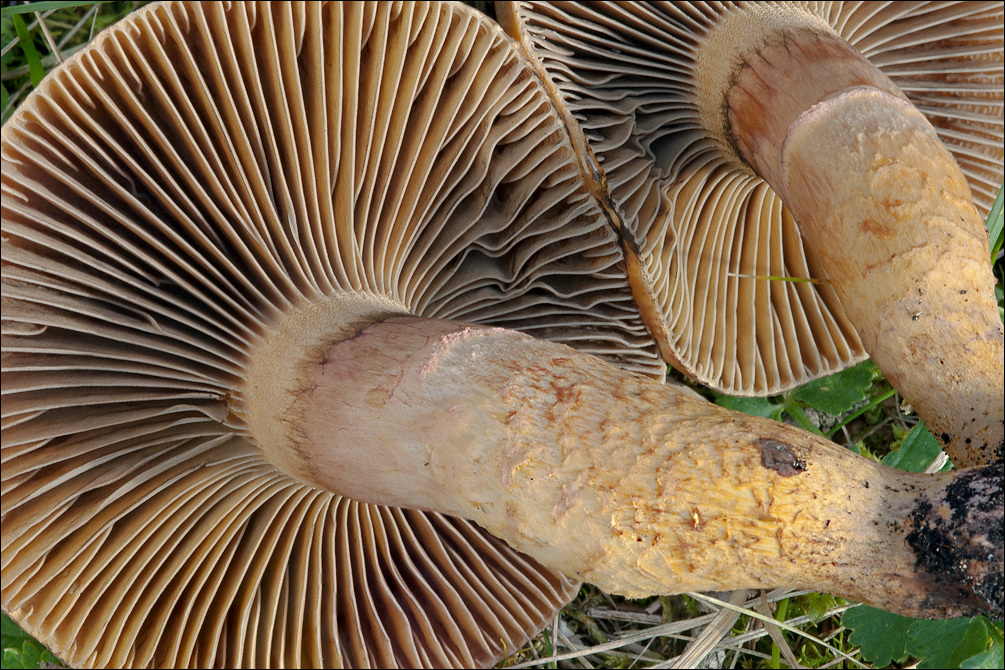
Slo.: bakreni polar - syn.: Gomphidius viscidus (L.) Fr. - Habitat: sandy grassland; mixed broadleaved and conifer wood edge; Picea abies, Pinus sylvestris, Salix eleagnos in the vicinity; semiruderal, calcareous ground; flat terrain; dry, half sunny place; exposed to direct rain; average precipitations ~ 3.000 mm/year, average temperature 7-9 deg C, elevation 580 m (1.900 feet), alpine phytogeographical region. Substratum: soil. Comments: Croomogomphus rutilus is a quite common fungus in this region. Two other species Chroomogomhus helveticus and C. glutinosus grow in the same region. It is not always simple to tell them apart. C. glutinosus is normally very slimy and grows always under Picea abies while Croomogomphus rutilus grows only under two-needle pines. C. helveticus is rarely slimy but grows under Picea abies, two- and fife-needle Pinus species. Inamyloid hypha of the pileipellis is another more demanding distinguishing character. Spore dimensions are very similar of all three and hence of little help in discrimination. Different mycorrhizal partners also did not help in identification of this find since Picea abies and Pinus sylvestris (a two-needle species) were in the vicinity. Yet, characteristic copper tone of the pilei seems to be quite a reliable feature for Croomogomphus rutilus. Growing in small groups of a few fruit bodies and solitary; SP abundant, grayish-brown. Spores smooth. Dimensions 17,3 [18,5 ; 19,1] 20,3 x 5,8 [6,4 ; 6,6] 7,1 microns; Q = 2,6 [2,8 ; 3] 3,2; N = 24; C = 95%; Me = 18,8 x 6,5 microns; Qe = 2,9. Olympus CH20, NEA 100x/1.25, magnification 1.000 x, oil, in water, fresh material. AmScope MA500 digital camera. Ref.: (1) J. Breitenbach, F. Kraenzlin, Eds., Fungi of Switzerland, Vol.3. Verlag Mykologia (1991), p 96. (2) G.J. Krieglsteiner (Hrsg.), Die Grosspilze Baden-Wrttembergs, Band 2., Ulmer (2000), p 341. (3) M. Bon, Parey's Buch der Pilze, Kosmos (2005), p 50. (4) R.Phillips, Mushrooms, Macmillan (2006), p 271. (5) S.Buczacki, Collins Fungi Guide, Collins (2012), p 422.
-

Slo.: bakreni polar - syn.: Gomphidius viscidus (L.) Fr. - Habitat: sandy grassland; mixed broadleaved and conifer wood edge; Picea abies, Pinus sylvestris, Salix eleagnos in the vicinity; semiruderal, calcareous ground; flat terrain; dry, half sunny place; exposed to direct rain; average precipitations ~ 3.000 mm/year, average temperature 7-9 deg C, elevation 580 m (1.900 feet), alpine phytogeographical region. Substratum: soil. Comments: Croomogomphus rutilus is a quite common fungus in this region. Two other species Chroomogomhus helveticus and C. glutinosus grow in the same region. It is not always simple to tell them apart. C. glutinosus is normally very slimy and grows always under Picea abies while Croomogomphus rutilus grows only under two-needle pines. C. helveticus is rarely slimy but grows under Picea abies, two- and fife-needle Pinus species. Inamyloid hypha of the pileipellis is another more demanding distinguishing character. Spore dimensions are very similar of all three and hence of little help in discrimination. Different mycorrhizal partners also did not help in identification of this find since Picea abies and Pinus sylvestris (a two-needle species) were in the vicinity. Yet, characteristic copper tone of the pilei seems to be quite a reliable feature for Croomogomphus rutilus. Growing in small groups of a few fruit bodies and solitary; SP abundant, grayish-brown. Spores smooth. Dimensions 17,3 [18,5 ; 19,1] 20,3 x 5,8 [6,4 ; 6,6] 7,1 microns; Q = 2,6 [2,8 ; 3] 3,2; N = 24; C = 95%; Me = 18,8 x 6,5 microns; Qe = 2,9. Olympus CH20, NEA 100x/1.25, magnification 1.000 x, oil, in water, fresh material. AmScope MA500 digital camera. Ref.: (1) J. Breitenbach, F. Kraenzlin, Eds., Fungi of Switzerland, Vol.3. Verlag Mykologia (1991), p 96. (2) G.J. Krieglsteiner (Hrsg.), Die Grosspilze Baden-Wrttembergs, Band 2., Ulmer (2000), p 341. (3) M. Bon, Parey's Buch der Pilze, Kosmos (2005), p 50. (4) R.Phillips, Mushrooms, Macmillan (2006), p 271. (5) S.Buczacki, Collins Fungi Guide, Collins (2012), p 422.
-
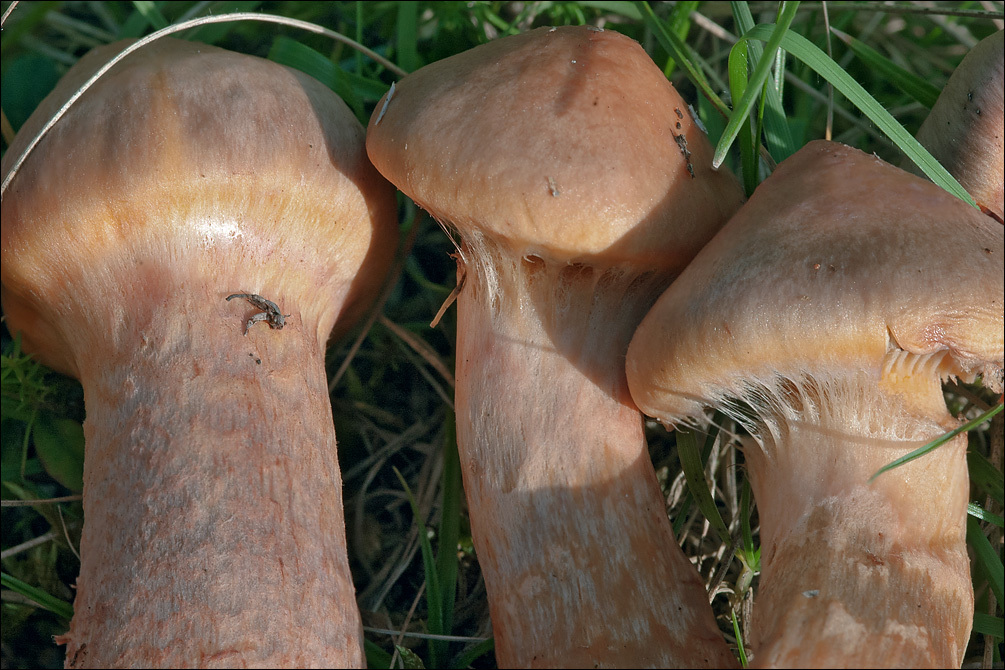
Slo.: bakreni polar - syn.: Gomphidius viscidus (L.) Fr. - Habitat: sandy grassland; mixed broadleaved and conifer wood edge; Picea abies, Pinus sylvestris, Salix eleagnos in the vicinity; semiruderal, calcareous ground; flat terrain; dry, half sunny place; exposed to direct rain; average precipitations ~ 3.000 mm/year, average temperature 7-9 deg C, elevation 580 m (1.900 feet), alpine phytogeographical region. Substratum: soil. Comments: Croomogomphus rutilus is a quite common fungus in this region. Two other species Chroomogomhus helveticus and C. glutinosus grow in the same region. It is not always simple to tell them apart. C. glutinosus is normally very slimy and grows always under Picea abies while Croomogomphus rutilus grows only under two-needle pines. C. helveticus is rarely slimy but grows under Picea abies, two- and fife-needle Pinus species. Inamyloid hypha of the pileipellis is another more demanding distinguishing character. Spore dimensions are very similar of all three and hence of little help in discrimination. Different mycorrhizal partners also did not help in identification of this find since Picea abies and Pinus sylvestris (a two-needle species) were in the vicinity. Yet, characteristic copper tone of the pilei seems to be quite a reliable feature for Croomogomphus rutilus. Growing in small groups of a few fruit bodies and solitary; SP abundant, grayish-brown. Spores smooth. Dimensions 17,3 [18,5 ; 19,1] 20,3 x 5,8 [6,4 ; 6,6] 7,1 microns; Q = 2,6 [2,8 ; 3] 3,2; N = 24; C = 95%; Me = 18,8 x 6,5 microns; Qe = 2,9. Olympus CH20, NEA 100x/1.25, magnification 1.000 x, oil, in water, fresh material. AmScope MA500 digital camera. Ref.: (1) J. Breitenbach, F. Kraenzlin, Eds., Fungi of Switzerland, Vol.3. Verlag Mykologia (1991), p 96. (2) G.J. Krieglsteiner (Hrsg.), Die Grosspilze Baden-Wrttembergs, Band 2., Ulmer (2000), p 341. (3) M. Bon, Parey's Buch der Pilze, Kosmos (2005), p 50. (4) R.Phillips, Mushrooms, Macmillan (2006), p 271. (5) S.Buczacki, Collins Fungi Guide, Collins (2012), p 422.
-
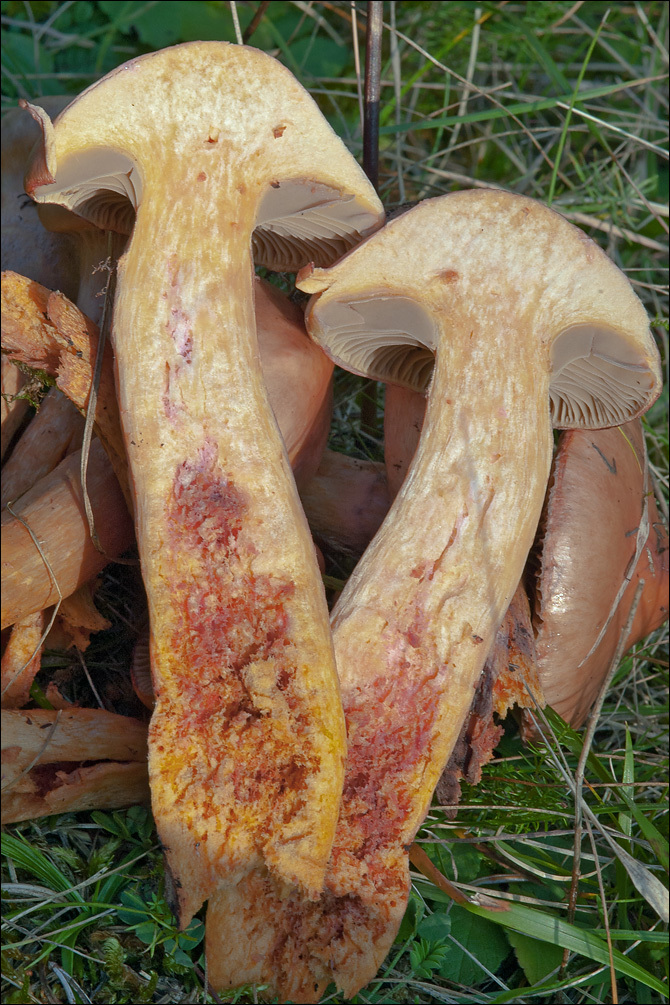
Slo.: bakreni polar - syn.: Gomphidius viscidus (L.) Fr. - Habitat: sandy grassland; mixed broadleaved and conifer wood edge; Picea abies, Pinus sylvestris, Salix eleagnos in the vicinity; semiruderal, calcareous ground; flat terrain; dry, half sunny place; exposed to direct rain; average precipitations ~ 3.000 mm/year, average temperature 7-9 deg C, elevation 580 m (1.900 feet), alpine phytogeographical region. Substratum: soil. Comments: Croomogomphus rutilus is a quite common fungus in this region. Two other species Chroomogomhus helveticus and C. glutinosus grow in the same region. It is not always simple to tell them apart. C. glutinosus is normally very slimy and grows always under Picea abies while Croomogomphus rutilus grows only under two-needle pines. C. helveticus is rarely slimy but grows under Picea abies, two- and fife-needle Pinus species. Inamyloid hypha of the pileipellis is another more demanding distinguishing character. Spore dimensions are very similar of all three and hence of little help in discrimination. Different mycorrhizal partners also did not help in identification of this find since Picea abies and Pinus sylvestris (a two-needle species) were in the vicinity. Yet, characteristic copper tone of the pilei seems to be quite a reliable feature for Croomogomphus rutilus. Growing in small groups of a few fruit bodies and solitary; SP abundant, grayish-brown. Spores smooth. Dimensions 17,3 [18,5 ; 19,1] 20,3 x 5,8 [6,4 ; 6,6] 7,1 microns; Q = 2,6 [2,8 ; 3] 3,2; N = 24; C = 95%; Me = 18,8 x 6,5 microns; Qe = 2,9. Olympus CH20, NEA 100x/1.25, magnification 1.000 x, oil, in water, fresh material. AmScope MA500 digital camera. Ref.: (1) J. Breitenbach, F. Kraenzlin, Eds., Fungi of Switzerland, Vol.3. Verlag Mykologia (1991), p 96. (2) G.J. Krieglsteiner (Hrsg.), Die Grosspilze Baden-Wrttembergs, Band 2., Ulmer (2000), p 341. (3) M. Bon, Parey's Buch der Pilze, Kosmos (2005), p 50. (4) R.Phillips, Mushrooms, Macmillan (2006), p 271. (5) S.Buczacki, Collins Fungi Guide, Collins (2012), p 422.
-
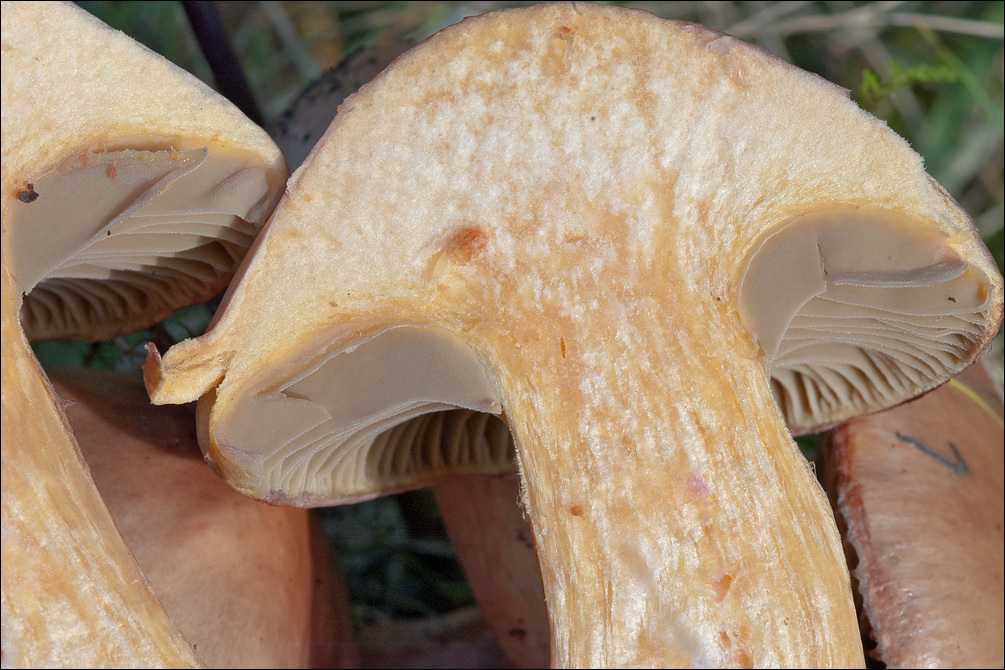
Slo.: bakreni polar - syn.: Gomphidius viscidus (L.) Fr. - Habitat: sandy grassland; mixed broadleaved and conifer wood edge; Picea abies, Pinus sylvestris, Salix eleagnos in the vicinity; semiruderal, calcareous ground; flat terrain; dry, half sunny place; exposed to direct rain; average precipitations ~ 3.000 mm/year, average temperature 7-9 deg C, elevation 580 m (1.900 feet), alpine phytogeographical region. Substratum: soil. Comments: Croomogomphus rutilus is a quite common fungus in this region. Two other species Chroomogomhus helveticus and C. glutinosus grow in the same region. It is not always simple to tell them apart. C. glutinosus is normally very slimy and grows always under Picea abies while Croomogomphus rutilus grows only under two-needle pines. C. helveticus is rarely slimy but grows under Picea abies, two- and fife-needle Pinus species. Inamyloid hypha of the pileipellis is another more demanding distinguishing character. Spore dimensions are very similar of all three and hence of little help in discrimination. Different mycorrhizal partners also did not help in identification of this find since Picea abies and Pinus sylvestris (a two-needle species) were in the vicinity. Yet, characteristic copper tone of the pilei seems to be quite a reliable feature for Croomogomphus rutilus. Growing in small groups of a few fruit bodies and solitary; SP abundant, grayish-brown. Spores smooth. Dimensions 17,3 [18,5 ; 19,1] 20,3 x 5,8 [6,4 ; 6,6] 7,1 microns; Q = 2,6 [2,8 ; 3] 3,2; N = 24; C = 95%; Me = 18,8 x 6,5 microns; Qe = 2,9. Olympus CH20, NEA 100x/1.25, magnification 1.000 x, oil, in water, fresh material. AmScope MA500 digital camera. Ref.: (1) J. Breitenbach, F. Kraenzlin, Eds., Fungi of Switzerland, Vol.3. Verlag Mykologia (1991), p 96. (2) G.J. Krieglsteiner (Hrsg.), Die Grosspilze Baden-Wrttembergs, Band 2., Ulmer (2000), p 341. (3) M. Bon, Parey's Buch der Pilze, Kosmos (2005), p 50. (4) R.Phillips, Mushrooms, Macmillan (2006), p 271. (5) S.Buczacki, Collins Fungi Guide, Collins (2012), p 422.
-
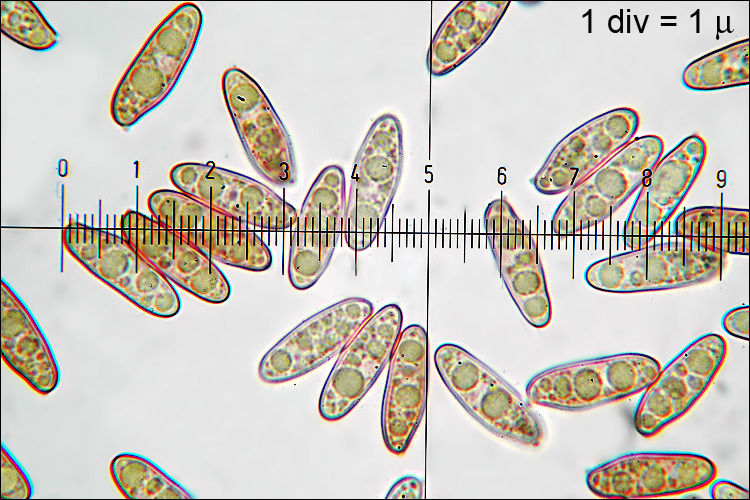
Slo.: bakreni polar - syn.: Gomphidius viscidus (L.) Fr. - Habitat: sandy grassland; mixed broadleaved and conifer wood edge; Picea abies, Pinus sylvestris, Salix eleagnos in the vicinity; semiruderal, calcareous ground; flat terrain; dry, half sunny place; exposed to direct rain; average precipitations ~ 3.000 mm/year, average temperature 7-9 deg C, elevation 580 m (1.900 feet), alpine phytogeographical region. Substratum: soil. Comments: Croomogomphus rutilus is a quite common fungus in this region. Two other species Chroomogomhus helveticus and C. glutinosus grow in the same region. It is not always simple to tell them apart. C. glutinosus is normally very slimy and grows always under Picea abies while Croomogomphus rutilus grows only under two-needle pines. C. helveticus is rarely slimy but grows under Picea abies, two- and fife-needle Pinus species. Inamyloid hypha of the pileipellis is another more demanding distinguishing character. Spore dimensions are very similar of all three and hence of little help in discrimination. Different mycorrhizal partners also did not help in identification of this find since Picea abies and Pinus sylvestris (a two-needle species) were in the vicinity. Yet, characteristic copper tone of the pilei seems to be quite a reliable feature for Croomogomphus rutilus. Growing in small groups of a few fruit bodies and solitary; SP abundant, grayish-brown. Spores smooth. Dimensions 17,3 [18,5 ; 19,1] 20,3 x 5,8 [6,4 ; 6,6] 7,1 microns; Q = 2,6 [2,8 ; 3] 3,2; N = 24; C = 95%; Me = 18,8 x 6,5 microns; Qe = 2,9. Olympus CH20, NEA 100x/1.25, magnification 1.000 x, oil, in water, fresh material. AmScope MA500 digital camera. Ref.: (1) J. Breitenbach, F. Kraenzlin, Eds., Fungi of Switzerland, Vol.3. Verlag Mykologia (1991), p 96. (2) G.J. Krieglsteiner (Hrsg.), Die Grosspilze Baden-Wrttembergs, Band 2., Ulmer (2000), p 341. (3) M. Bon, Parey's Buch der Pilze, Kosmos (2005), p 50. (4) R.Phillips, Mushrooms, Macmillan (2006), p 271. (5) S.Buczacki, Collins Fungi Guide, Collins (2012), p 422.
-
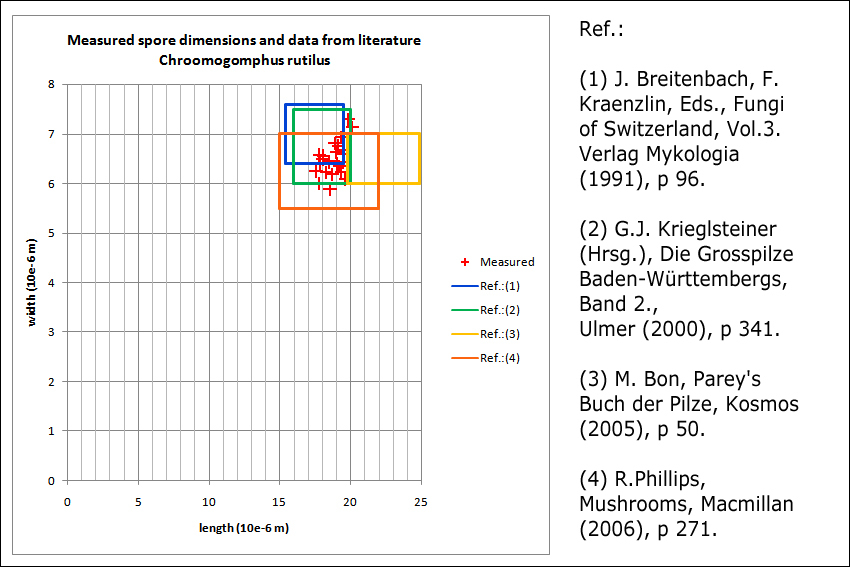
Slo.: bakreni polar - syn.: Gomphidius viscidus (L.) Fr. - Habitat: sandy grassland; mixed broadleaved and conifer wood edge; Picea abies, Pinus sylvestris, Salix eleagnos in the vicinity; semiruderal, calcareous ground; flat terrain; dry, half sunny place; exposed to direct rain; average precipitations ~ 3.000 mm/year, average temperature 7-9 deg C, elevation 580 m (1.900 feet), alpine phytogeographical region. Substratum: soil. Comments: Croomogomphus rutilus is a quite common fungus in this region. Two other species Chroomogomhus helveticus and C. glutinosus grow in the same region. It is not always simple to tell them apart. C. glutinosus is normally very slimy and grows always under Picea abies while Croomogomphus rutilus grows only under two-needle pines. C. helveticus is rarely slimy but grows under Picea abies, two- and fife-needle Pinus species. Inamyloid hypha of the pileipellis is another more demanding distinguishing character. Spore dimensions are very similar of all three and hence of little help in discrimination. Different mycorrhizal partners also did not help in identification of this find since Picea abies and Pinus sylvestris (a two-needle species) were in the vicinity. Yet, characteristic copper tone of the pilei seems to be quite a reliable feature for Croomogomphus rutilus. Growing in small groups of a few fruit bodies and solitary; SP abundant, grayish-brown. Spores smooth. Dimensions 17,3 [18,5 ; 19,1] 20,3 x 5,8 [6,4 ; 6,6] 7,1 microns; Q = 2,6 [2,8 ; 3] 3,2; N = 24; C = 95%; Me = 18,8 x 6,5 microns; Qe = 2,9. Olympus CH20, NEA 100x/1.25, magnification 1.000 x, oil, in water, fresh material. AmScope MA500 digital camera. Ref.: (1) J. Breitenbach, F. Kraenzlin, Eds., Fungi of Switzerland, Vol.3. Verlag Mykologia (1991), p 96. (2) G.J. Krieglsteiner (Hrsg.), Die Grosspilze Baden-Wrttembergs, Band 2., Ulmer (2000), p 341. (3) M. Bon, Parey's Buch der Pilze, Kosmos (2005), p 50. (4) R.Phillips, Mushrooms, Macmillan (2006), p 271. (5) S.Buczacki, Collins Fungi Guide, Collins (2012), p 422.
-
Slo.: bakreni polar - Habitat: Foot of an overgrown alpine scree slope, among grass, Vaccinium myrtillus, Vaccinium vitis-idaea, Lycopodium annotinum and other acid ground loving species, calcareous bedrock, under a Pinus mugo, almost flat terrain, quite sunny place, exposed to direct rain, average precipitations ~ 3.000 mm/year, average temperature 3-5 deg C, elevation 1.350 m (4.450 feet), alpine phytogeographical region. - Substratum: acid soil under a Pinus mugo. - Comments: Growing solitary, taste and smell indistinctive, SP dark gray. Spores smooth, dimensions: 17.8 (SD = 0.9) x 6.0 (SD = 0.3) micr., Q = 3.0 (SD = 0.16), n = 33. Motic B1-211A, Olymus NEA 100x/1.25, magnification 1.000 x, oil, in water. - Ref.: (1) S.Buczacki, Collins Fungi Guide, Collins (2012), p 422. (2) M.Bon, Parey's Buch der Pilze, Kosmos (2005), p 50. (3) R.Phillips, Mushrooms, Macmillan (2006), p 271. (4) G.J.Krieglsteiner (Hrsg.), Die Grosspilze Bade-Wrttembergs, Band 2., Ulmer (2000), p 341.
-
Slo.: bakreni polar - Habitat: Foot of an overgrown alpine scree slope, among grass, Vaccinium myrtillus, Vaccinium vitis-idaea, Lycopodium annotinum and other acid ground loving species, calcareous bedrock, under a Pinus mugo, almost flat terrain, quite sunny place, exposed to direct rain, average precipitations ~ 3.000 mm/year, average temperature 3-5 deg C, elevation 1.350 m (4.450 feet), alpine phytogeographical region. - Substratum: acid soil under a Pinus mugo. - Comments: Growing solitary, taste and smell indistinctive, SP dark gray. Spores smooth, dimensions: 17.8 (SD = 0.9) x 6.0 (SD = 0.3) micr., Q = 3.0 (SD = 0.16), n = 33. Motic B1-211A, Olymus NEA 100x/1.25, magnification 1.000 x, oil, in water. - Ref.: (1) S.Buczacki, Collins Fungi Guide, Collins (2012), p 422. (2) M.Bon, Parey's Buch der Pilze, Kosmos (2005), p 50. (3) R.Phillips, Mushrooms, Macmillan (2006), p 271. (4) G.J.Krieglsteiner (Hrsg.), Die Grosspilze Bade-Wrttembergs, Band 2., Ulmer (2000), p 341.
-
Slo.: bakreni polar - Habitat: Foot of an overgrown alpine scree slope, among grass, Vaccinium myrtillus, Vaccinium vitis-idaea, Lycopodium annotinum and other acid ground loving species, calcareous bedrock, under a Pinus mugo, almost flat terrain, quite sunny place, exposed to direct rain, average precipitations ~ 3.000 mm/year, average temperature 3-5 deg C, elevation 1.350 m (4.450 feet), alpine phytogeographical region. - Substratum: acid soil under a Pinus mugo. - Comments: Growing solitary, taste and smell indistinctive, SP dark gray. Spores smooth, dimensions: 17.8 (SD = 0.9) x 6.0 (SD = 0.3) micr., Q = 3.0 (SD = 0.16), n = 33. Motic B1-211A, Olymus NEA 100x/1.25, magnification 1.000 x, oil, in water. - Ref.: (1) S.Buczacki, Collins Fungi Guide, Collins (2012), p 422. (2) M.Bon, Parey's Buch der Pilze, Kosmos (2005), p 50. (3) R.Phillips, Mushrooms, Macmillan (2006), p 271. (4) G.J.Krieglsteiner (Hrsg.), Die Grosspilze Bade-Wrttembergs, Band 2., Ulmer (2000), p 341.
-
Slo.: bakreni polar - Habitat: Foot of an overgrown alpine scree slope, among grass, Vaccinium myrtillus, Vaccinium vitis-idaea, Lycopodium annotinum and other acid ground loving species, calcareous bedrock, under a Pinus mugo, almost flat terrain, quite sunny place, exposed to direct rain, average precipitations ~ 3.000 mm/year, average temperature 3-5 deg C, elevation 1.350 m (4.450 feet), alpine phytogeographical region. - Substratum: acid soil under a Pinus mugo. - Comments: Growing solitary, taste and smell indistinctive, SP dark gray. Spores smooth, dimensions: 17.8 (SD = 0.9) x 6.0 (SD = 0.3) micr., Q = 3.0 (SD = 0.16), n = 33. Motic B1-211A, Olymus NEA 100x/1.25, magnification 1.000 x, oil, in water. - Ref.: (1) S.Buczacki, Collins Fungi Guide, Collins (2012), p 422. (2) M.Bon, Parey's Buch der Pilze, Kosmos (2005), p 50. (3) R.Phillips, Mushrooms, Macmillan (2006), p 271. (4) G.J.Krieglsteiner (Hrsg.), Die Grosspilze Bade-Wrttembergs, Band 2., Ulmer (2000), p 341.
-
Slo.: bakreni polar - Habitat: Foot of an overgrown alpine scree slope, among grass, Vaccinium myrtillus, Vaccinium vitis-idaea, Lycopodium annotinum and other acid ground loving species, calcareous bedrock, under a Pinus mugo, almost flat terrain, quite sunny place, exposed to direct rain, average precipitations ~ 3.000 mm/year, average temperature 3-5 deg C, elevation 1.350 m (4.450 feet), alpine phytogeographical region. - Substratum: acid soil under a Pinus mugo. - Comments: Growing solitary, taste and smell indistinctive, SP dark gray. Spores smooth, dimensions: 17.8 (SD = 0.9) x 6.0 (SD = 0.3) micr., Q = 3.0 (SD = 0.16), n = 33. Motic B1-211A, Olymus NEA 100x/1.25, magnification 1.000 x, oil, in water. - Ref.: (1) S.Buczacki, Collins Fungi Guide, Collins (2012), p 422. (2) M.Bon, Parey's Buch der Pilze, Kosmos (2005), p 50. (3) R.Phillips, Mushrooms, Macmillan (2006), p 271. (4) G.J.Krieglsteiner (Hrsg.), Die Grosspilze Bade-Wrttembergs, Band 2., Ulmer (2000), p 341.
-
Slo.: bakreni polar - Habitat: Foot of an overgrown alpine scree slope, among grass, Vaccinium myrtillus, Vaccinium vitis-idaea, Lycopodium annotinum and other acid ground loving species, calcareous bedrock, under a Pinus mugo, almost flat terrain, quite sunny place, exposed to direct rain, average precipitations ~ 3.000 mm/year, average temperature 3-5 deg C, elevation 1.350 m (4.450 feet), alpine phytogeographical region. - Substratum: acid soil under a Pinus mugo. - Comments: Growing solitary, taste and smell indistinctive, SP dark gray. Spores smooth, dimensions: 17.8 (SD = 0.9) x 6.0 (SD = 0.3) micr., Q = 3.0 (SD = 0.16), n = 33. Motic B1-211A, Olymus NEA 100x/1.25, magnification 1.000 x, oil, in water. - Ref.: (1) S.Buczacki, Collins Fungi Guide, Collins (2012), p 422. (2) M.Bon, Parey's Buch der Pilze, Kosmos (2005), p 50. (3) R.Phillips, Mushrooms, Macmillan (2006), p 271. (4) G.J.Krieglsteiner (Hrsg.), Die Grosspilze Bade-Wrttembergs, Band 2., Ulmer (2000), p 341.
-
Slo.: bakreni polar - Habitat: Foot of an overgrown alpine scree slope, among grass, Vaccinium myrtillus, Vaccinium vitis-idaea, Lycopodium annotinum and other acid ground loving species, calcareous bedrock, under a Pinus mugo, almost flat terrain, quite sunny place, exposed to direct rain, average precipitations ~ 3.000 mm/year, average temperature 3-5 deg C, elevation 1.350 m (4.450 feet), alpine phytogeographical region. - Substratum: acid soil under a Pinus mugo. - Comments: Growing solitary, taste and smell indistinctive, SP dark gray. Spores smooth, dimensions: 17.8 (SD = 0.9) x 6.0 (SD = 0.3) micr., Q = 3.0 (SD = 0.16), n = 33. Motic B1-211A, Olymus NEA 100x/1.25, magnification 1.000 x, oil, in water. - Ref.: (1) S.Buczacki, Collins Fungi Guide, Collins (2012), p 422. (2) M.Bon, Parey's Buch der Pilze, Kosmos (2005), p 50. (3) R.Phillips, Mushrooms, Macmillan (2006), p 271. (4) G.J.Krieglsteiner (Hrsg.), Die Grosspilze Bade-Wrttembergs, Band 2., Ulmer (2000), p 341.
-
2001 California Academy of Sciences
CalPhotos
-
2001 California Academy of Sciences
CalPhotos
-
2001 California Academy of Sciences
CalPhotos
-
2001 California Academy of Sciences
CalPhotos
-
2001 California Academy of Sciences
CalPhotos
-
Slo.: veliki slinar - Habitat: Consolidated alluvial deposits of a mountain stream, calcareous sandy ground, among grasses, half under a small (1.5 m 5 feet tall) Picea abies, pretty sunny and dry place, exposed to direct rain, average precipitations ~3.000 mm/year, average temperatures 5-7 deg C, elevation 900 m (3.000 feet), alpine phytogeographical region. - Substratum: sandy soil. - Comment: spore print abundant, dark blackish chesnut-brown. - Ref.: - G. Pace, Vse o gobah (in Slovene), Mladinska Knjiga (1997), p242. - J.Grom, Nae gobe (in Slovene), epna Knjiga, (1981), p96. - Spore picture: magnification 1.000x, Motic B1-211 and Nikon D70, Nikkor 50 mm/f1.8
-
Slo.: veliki slinar - Habitat: Consolidated alluvial deposits of a mountain stream, calcareous sandy ground, among grasses, half under a small (1.5 m 5 feet tall) Picea abies, pretty sunny and dry place, exposed to direct rain, average precipitations ~3.000 mm/year, average temperatures 5-7 deg C, elevation 900 m (3.000 feet), alpine phytogeographical region. - Substratum: sandy soil. - Comment: spore print abundant, dark blackish chesnut-brown. - Ref.: - G. Pace, Vse o gobah (in Slovene), Mladinska Knjiga (1997), p242. - J.Grom, Nae gobe (in Slovene), epna Knjiga, (1981), p96. - Spore picture: magnification 1.000x, Motic B1-211 and Nikon D70, Nikkor 50 mm/f1.8
-
Slo.: veliki slinar - Habitat: Consolidated alluvial deposits of a mountain stream, calcareous sandy ground, among grasses, half under a small (1.5 m 5 feet tall) Picea abies, pretty sunny and dry place, exposed to direct rain, average precipitations ~3.000 mm/year, average temperatures 5-7 deg C, elevation 900 m (3.000 feet), alpine phytogeographical region. - Substratum: sandy soil. - Comment: spore print abundant, dark blackish chesnut-brown. - Ref.: - G. Pace, Vse o gobah (in Slovene), Mladinska Knjiga (1997), p242. - J.Grom, Nae gobe (in Slovene), epna Knjiga, (1981), p96. - Spore picture: magnification 1.000x, Motic B1-211 and Nikon D70, Nikkor 50 mm/f1.8
-
Slo.: veliki slinar - Habitat: Consolidated alluvial deposits of a mountain stream, calcareous sandy ground, among grasses, half under a small (1.5 m 5 feet tall) Picea abies, pretty sunny and dry place, exposed to direct rain, average precipitations ~3.000 mm/year, average temperatures 5-7 deg C, elevation 900 m (3.000 feet), alpine phytogeographical region. - Substratum: sandy soil. - Comment: spore print abundant, dark blackish chesnut-brown. - Ref.: - G. Pace, Vse o gobah (in Slovene), Mladinska Knjiga (1997), p242. - J.Grom, Nae gobe (in Slovene), epna Knjiga, (1981), p96. - Spore picture: magnification 1.000x, Motic B1-211 and Nikon D70, Nikkor 50 mm/f1.8

